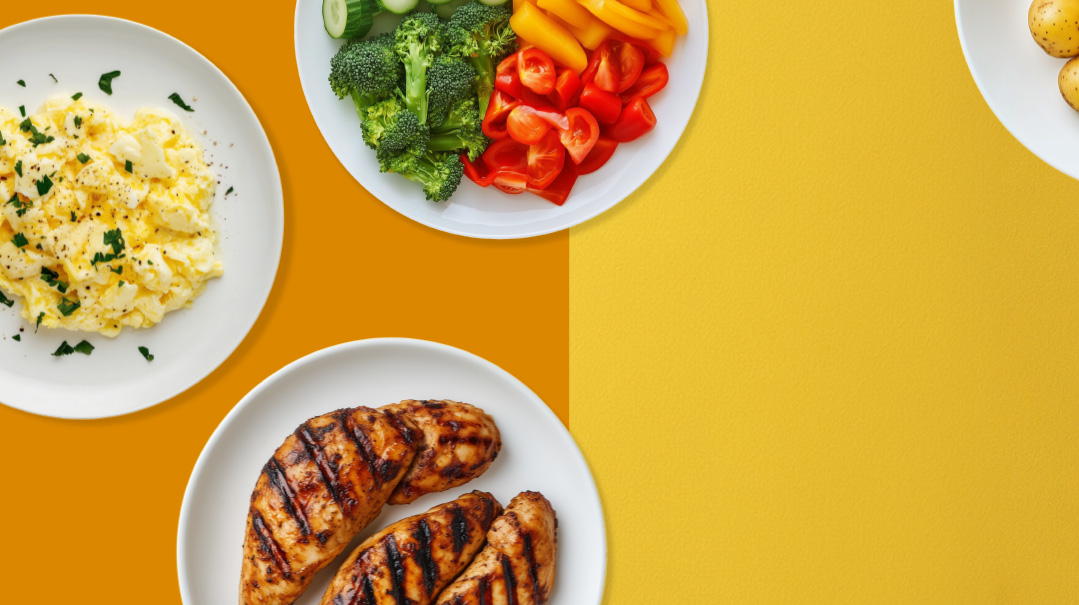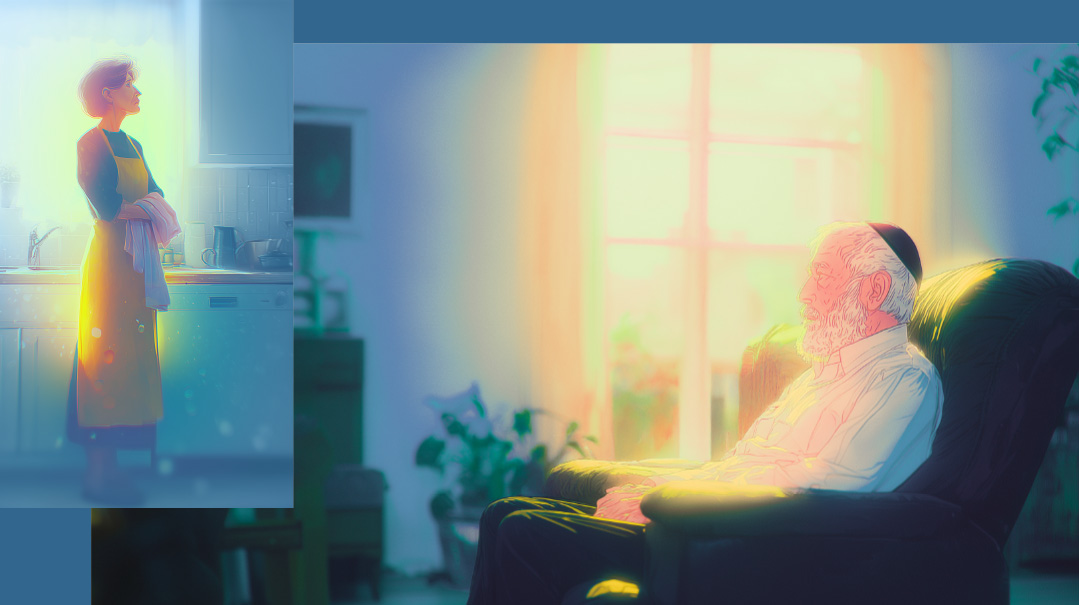Healing On a Plate
| August 14, 2024My daughter was sick — and getting sicker. Then I looked at her diet and discovered the healing power of food

As told to Shoshana Gross
Esty was my kvetchy kid. I took it as truth that every mother had one of those children. I brushed off her lethargy and her tendency to follow me around whining, “Mooommy!” as yet another phase in the “terrible twos.” When I sat, Esty’s head instantly nestled in my lap. When I walked, Esty clung to my skirt like a limpet. When she came home from playgroup, she would already be sprawled on the floor, asleep, before I could put together an after-school snack.
“What’s wrong with her?” asked my friends and sister and mother and mother-in-law.
“She’s two,” I answered, unconcerned.
And then her morah asked me.
“Esty’s probably tired from running around!” I said with a laugh.
“She doesn’t play at school. She sits all day. Why is she always so tired?”
I had no answer, and the first stirrings of unease took hold.
“What’s wrong with her?” I asked the pediatrician at her four-year-old well visit, after explaining Esty’s symptoms and behaviors.
“The only thing I’m concerned about is that your daughter hasn’t gained an ounce since her third birthday,” he replied. We looked at Esty, who slumped on the doctor’s examining table, pale and languid.
I explained that she was a picky eater who complained of stomach pain after every two bites of food.
“Maybe she’s a slow grower,” the pediatrician said, and we left it at that.
A few months later, I was helping Esty get dressed when I noticed a strange rash, oozing pus, behind her ear. This was soon joined by an odd red patch on the side of her nose. We hustled to the doctor.
“It’s two separate skin infections. Coincidence,” the doctor told us confidently, typing out a prescription for antibiotics. The rashes went away… and then reappeared as soon as the medication was done.
This was a medical puzzle, and our pediatrician relished the challenge.
“It must be something internal. Let’s do some bloodwork, and maybe we can find a connection between these totally unrelated skin conditions,” he concluded.
And that was how I was introduced to a whole new vocabulary of medical jargon.
The bloodwork indicated that Esty’s ESR was elevated. So was her CRP. ESR and CRP were terms for the measurements of inflammation levels in a person’s blood. I didn’t know it then, but I was going to become an expert in this new language of chronic illness. The normal range was ten to 15. Esty’s was 90. But her iron levels were also low, so the doctor focused on that. She was only four, and he saw no reason to look any further.
“All Esty needs is an iron infusion, and she’ll be a different girl,” the doctor reassured me. Innocent in the ways of hospitals, I came on time to the appointment, at an unearthly hour, with both my newborn and a decidedly uncooperative toddler. When we were finally ushered into the room to endure the hour-long procedure, as I held a screaming child in each arm, I davened for the magical transformation.
It never happened. We tried a second infusion. No change.
Esty’s skin rash faded, the doctor assured me that all would be well, and I resigned myself to parenting a lethargic, kvetchy child until she grew out of it.
As Low as Possible
An ordinary visit to the dentist upended our complacency. Esty wasn’t exactly a cooperative patient, but she had cavities that needed filling, so she needed to be sedated. The anesthesiologist asked me a series of routine questions before sedating her, and I mentioned the saga of iron infusions and blood inflammation. There was a pause, and then she insisted on doing a new set of labs on the spot.
The dentist came in with the test results, his expression grave.
“Go to a specialist,” he said bluntly. “I won’t do any procedure on your daughter until you do something. Her iron level is normal, but her blood inflammation markers are unusually high.”
It was the beginning of the Endless Specialist Merry-Go-Round. First came the pediatrician, who sent us to the infectious disease doctor (both skin rashes were back and unresponsive to his creams), who sent us on to the hematologist who suspected rheumatoid arthritis but wasn’t sure, so he sent us to a pediatric gastroenterologist — who took Esty’s weight, looked at her pale face and purple-shadowed eyes, and proclaimed, “Crohn’s!” A colonoscopy was conclusive. Apparently, Crohn’s was the culprit impairing Esty’s immune system, causing the baffling skin rashes. The pediatrician was shocked — he had never seen Crohn’s in such a young child — and we had a hard time processing the news.
I knew, vaguely, what Crohn’s was, but my doctor spared us no details. It’s an inflammatory bowel disease (IBD) which causes inflammation (swelling of the tissues) in the digestive tract. It can affect both the small and large intestine. When he told us the symptoms of Crohn’s — abdominal pain, severe diarrhea, weight loss, malnutrition, and fatigue — I felt like he was describing Esty.
When we started thinking clearly again, we greeted the diagnosis with a mixture of relief and terror. Esty’s case wasn’t a mild one, and she started steroids to control the intestinal inflammation, as well as immunosuppressants to stop her immune system from flaring up and causing her pain.
The side effects weren’t fun. Esty’s face blew up, prompting surprised, “What happened to her face?” comments from too many people.
A few weeks into treatment, Esty had a little more energy. A little more pink in her cheeks. She wasn’t in the bathroom as often. Her blood inflammation plummeted from 90 to 45. I was jubilant. Her gastroenterologist frowned.
“I don’t like it,” said the gastroenterologist. “She’s not responding properly to the medications. I want her numbers at fifteen. We need to go as low as possible.” He doubled the dose of steroids.
Every three to four weeks I drove to a distant compounding pharmacy to crush her steroids and immunosuppressants into liquid. We added a regimen of medications for stomach acid and other issues. Our counter looked like a miniature pharmacy, with rows of powders and liquids and bottles. After the double-dose round of steroids, Esty’s numbers were down to 30. All that effort, all that medicine, all that time, and her inflammation numbers were still not in the normal range.
A Wonder Drug
A year into treatment, we didn’t have much to show beyond the basic, early improvement. Esty was still not as energetic as other girls her age, her stomach still bothered her sometimes, and she was taking a cornucopia of medications that would put an octogenarian to shame.
“Time for the next step,” our gastroenterologist said. “We have a wonderful drug administered through an IV infusion. It’s called Remicade, and it really works.”
If Remicade was so wonderful, why hadn’t our gastroenterologist prescribed it right away? Some research showed that Remicade was an extremely powerful drug administered to patients with Crohn’s and other autoimmune diseases through an IV. I discovered that it blocks certain protein factors responsible for inflammation, and in doing so, lowers the immune system’s ability to resist infection. Then I found out that five to ten percent of patients on Remicade developed cancer, and it was a gastroenterologist’s last-resort weapon.
To my worries about cancer, our doctor responded, “It could happen, but that’s a future problem. In medicine, we treat the immediate problem. Esty’s in a dangerous position, and we have to treat her.”
“Okay, let’s do it,” I said. “How many treatments will she need?”
“It’s forever,” he answered. “Every six weeks for life.”
Something about forever shook me. I paused, and thought about this life sentence we were passing on my five-year-old daughter.
Earlier, when news about my daughter’s diagnosis spread, I received a call from a woman who claimed to manage Crohn’s through a special diet called SCD — the Specific Carb Diet. I listened politely, thanked her, hung up, and laughed. We were in the hands of the best doctors at a world-renowned hospital. Crohn’s was serious; a weird diet wasn’t the solution.
I remembered that woman now. I wasn’t willing to try Remicade yet. Maybe this weird diet was the answer.
One Bag of Cashews at a Time
The gastroenterologist was horrified. “Esty’s numbers are still at thirty — that’s where many Crohn’s patients start! It means her intestines are inflamed, and too much inflammation can turn into scar tissue that can only be removed surgically. And sometimes, too much scar tissue can narrow the intestine until there’s a dangerous blockage. It’s painful and extremely risky. I know you want to do a diet, but the inflammation is deep inside her intestine. There’s no evidence your idea will work!”
I looked at my fragile little girl, and a powerful resolve took hold. I decided to try.
A memory resurfaced: the day of Esty’s colonoscopy. Her appointment was pushed off a few hours (a common occurrence in the hospital), and she was only allowed clear broth, liquids, and jello before the procedure. After the long day, I was sure Esty would be depleted. Her siblings were hanging up signs and wrapping cute gifts, but I wondered if she would have the strength to enjoy it. I was shocked when Esty bounded from the car, energetic and excited.
The New Esty lasted until her first pizza bagel. She was suddenly back to her usual tired, listless self. Maybe a better diet was the way to go.
With the backing of our pediatrician, who knew Esty’s regular diet — nibbles of five foods — we hoped that less, but more nutritious, food would help. We scheduled Esty’s first Remicade infusion in three months, and I spoke to the woman who’d called about SCD, plunging into the world of natural remedies.
The SCD diet was hard. Actually, “hard” is a charitable description. “Brutal” might be better. The idea behind SCD was that there are certain foods the intestines of people with Crohn’s can’t tolerate, namely carbs. Not a crumb of gluten could touch Esty’s lips. All refined sugar went out the window. I memorized long lists of legal and illegal foods, and began to scour local supermarkets and stores for products I rarely used.
Turned out, stores in those days were as naturally clueless as I was.
Life revolved around preparing food for Esty, and preparing the ingredients to prepare her food. I baked cookies and bread out of almond flour, and created almond flour-cashew butter blueberry muffins. I bought bulk bags of cashews, toasted them, and ground them into cashew butter. If I realized we had no more muffins at midnight, it was time to open up shop and start toasting nuts. The first three days of the diet, Esty sulked and moped — but then she ate.
After one week, Esty wasn’t complaining about her stomach.
After two weeks, the color returned to her cheeks.
After three weeks, Esty was energetic. Laughing.
The gloomy predictions vanished at Esty’s three-month appointment. Her bloodwork was in the normal range, down to 15, and there was no need for Remicade.
“Can we stop all her medications?” I asked.
“Absolutely not. The medicines are finally kicking in,” the gastroenterologist informed me.
“What about Esty’s diet?” I persisted.
“We can’t argue with results,” he admitted. “Just keep everything the same.”
Back Again
One year of perfect bloodwork results, with Esty looking amazing, I stopped her steroids and immunosuppressants.
A few months later, after her next bloodwork, the puzzled doctor gave me a call.
“Everything looks normal except for one abnormally high number,” he began. I braced myself for the worst, heart sinking. “Esty’s vitamin D is too high,” he continued.
I almost melted with relief. “I’ve been giving her a supplement. I can stop,” I said in strangled voice, torn between the desire to laugh and cry. He was worried about her vitamin D? What about the Crohn’s?
“And her medications don’t seem to be showing up in her bloodwork. Her Imuran level [from one of the medications] didn’t appear on the test results.” He sounded nervous, but the flutter of hope inside took wings.
I finally understood.
“Um, that’s because she’s not on the medications anymore,” I admitted.
At that point, even the gastroenterologist admitted that the diet seemed miraculous. “This is the first time I’m seeing Esty completely healthy!” he marveled.
“Do you tell your clients about this diet?” I asked.
“There’s no scientific evidence that it works,” he said.
“There are actually certain hospitals that use the SCD diet, like Cincinnati’s Children’s Hospital,” I pointed out. I wanted to know why he’d never mentioned the existence of diets to help control Crohn’s. Why hadn’t I been given this choice from the beginning?
“It’s a hard diet,” he finally explained.
“It’s also hard to take a child to the hospital for IV infusions for the rest of her life,” I retorted. “Why not give parents a choice?”
“This is outside my medical knowledge,” he said. I respected his honesty. He was an expert who knew what he was taught about Crohn’s, and he wouldn’t recommend something he couldn’t guide his patients through — even if he saw the results in the form of my healthy, glowing daughter.
We returned to the gastroenterologist every few months, and slowly slid into the trap of complacency. After two years of SCD, we could add more foods to Esty’s diet, right? False confidence trumped caution, and allowing Esty to taste potatoes became, “Here, have a bag of chips!” And potato chips were only the beginning. The diet disappeared into the periphery of my mind, and Esty ate whatever she pleased. No diet, no medication.
Things seemed to be going well, but slowly, I noticed some changes. Esty’s face was slightly pale. She spent more time in the bathroom. But when she showed me the excruciatingly painful black-and-blue marks on her shins that made it hard for her to walk, I knew we needed to see her doctor. Everything together pointed to the one thing I’d hoped never to see again — Esty’s Crohn’s was active again.
“She’s back to where she started,” the doctor said flatly after her bloodwork. “Her numbers are back to ninety, and I can see she’s not doing well.”
“She’s just off her diet,” I told the gastroenterologist. “I’ll put her back on!”
But this time, he wouldn’t back down. She was in terrible condition, and because Esty had been off medication for a year, he feared Esty’s intestine might rupture soon, the dark nightmare of Crohn’s. The frighteningly high numbers of inflammation clinched it for him. She needed to start Remicade now.
“When she was first diagnosed, we had three months to work on Esty’s diet before we had to do Remicade. Can we try to put her back on SCD?” I begged.
“You don’t have three months this time,” he said. “Her body’s been through so much, and look how terrible her numbers are. You have one month, and then she’s starting IV infusions.”
We frantically tried to get an appointment at Cincinnati Children’s Hospital, because they conducted full workups for Crohn’s and advocated the use of the SCD diet. I hoped they could find a way to help Esty with SCD and not medication. With the dire warning that we had four weeks at most, we pulled endless strings. The call came in middle of my son’s siddur play — and it was off to Cincinnati.
A two-day trip. Fifteen vials of blood. Endless hours of waiting for the results.
Her results threw us into despair. There was no hope of putting Esty on SCD this time. She was at high risk for an intestinal rupture, and the hospital wouldn’t let us leave without beginning Remicade. There was just one more chance — enteral nutrition.
Enteral nutrition is the equivalent of formula for older children and adults. The formula itself was an eye-watering concoction of sugar, fillers, flavor, and vitamins thrown in for good measure — but if it helped, I was willing to try. Esty had to follow an eight-week program of this liquid-only diet, designed to bypass the intestines, letting them rest and heal. After the SCD diet, Esty was used to restrictions and didn’t object. Taking a small sip of strawberry-flavored formula, she smiled.
“I like it!”
Galvanized, I rounded up cute, pink water bottles, put together an extensive stash of flavored packets, and froze trays of ice cubes. On the first day of camp, I waved good-bye to an excited Esty, her pink water bottle filled with icy, life-giving liquid in hand.
She returned from camp pasty, shaking, and on the verge of passing out.
What was fine after one small sip was completely different after a few gulps. The lingering aftertaste bothered Esty, and she simply refused to try the formula again.
Three swallows into an eight-week regimen, nausea had wrecked her resolve.
A Chance to Heal
I threw out everything I’d ever known, and opened my mind to any and all information.
The desperation was fierce, and it pushed me to get on the computer and begin a tsunami of research. Ten years ago this was a new frontier, but I explored it all. Every doctor, every naturalist, notes from parents, patients, websites, and (probably) some quacks. There was a motley array of diets — FODMAP, high fiber, and low carb. We’d tried SCD, and I couldn’t imagine anyone maintaining that for life. Drowning in waves of words, the realization grabbed me with the saving grace of a lifebelt:
There was no magic to healing Crohn’s with SCD.
Avoiding irritating foods wasn’t a cure.
The magic was in giving the body healing foods in an easily digestible format so that the intestinal lining could repair itself, and so that the healthy microbes in the digestive system, which are often out of balance in people with digestive disease, could flourish.
I’d never heard of this concept before, but it struck me: SCD removed the irritants, but almond flour pancakes with maple syrup weren’t solving anything. Perhaps other foods — foods with healing properties — could. I spent the entire day researching, writing, discovering, and planning a liquid-only menu based around foods that were known to fight inflammation.
I bought adorable ice pop molds, and filled them with a mixture of fruits blended with aloe vera, which was supposed to help reduce inflammation and soothe the intestines.
Proudly sliding the tray into the freezer, I returned to my research.
Turmeric! That exotic, anti-inflammatory spice kept coming up. I rushed to the freezer, pulled out the popsicle sticks, tossed the icy slush into a bowl, mixed some turmeric in, and popped them back into the freezer. The discovery of coconut oil’s benefits prompted another trip to dump out the popsicles, blend in some coconut oil, and then spoon the odd-looking mixture back into the molds.
I was grasping at straws — but Esty enjoyed the ice pops. And celery juice and bone broth. And healthy blended vegetable soup. Soon she was her normal self again, and I cautiously hoped we were heading for a better place.
Two and a half anxious weeks later, I had my answer. Esty’s bloodwork was even more perfect than on SCD, her inflammation level almost at zero.
After a few days on the all-liquid diet, which placed less demand on her system to digest than solid food and thus gave it a break and a chance to recoup, her symptoms had gone away. She began eating plain chicken, salmon, and eggs. Every week or so, I added some foods, in the order of how easily digestible they were. Beginning with ripe fruit and cooked vegetables, I soon added raw vegetables, more proteins, and gluten-free carbs, such as rice. She soon moved on to potatoes, whole wheat breads and pasta, and healthier dairy (such as yogurt).
No more making homemade cashew butter and scrounging around for hard-to-find foods! Her colonoscopies, which had shown lots of inflammation when her Crohn’s flared up only a few short weeks before, looked incredible. Her bloodwork remained perfect.
Three months later, I added dairy and all gluten to her diet. In general, my family ate healthfully. There was health, but also balance, and I wanted Esty to have that, too. She ate nutritious food, enjoyed some sweet treats, and everything seemed fine.
Within six months, Esty was eating the same food as the rest of the family. Within a year, she was able to eat pizza and ice cream (in moderation!).
Esty was off any traditional diet, and was just eating the regular, healthful food I served the family. One busy Yom Tov, I simply let her eat tons of heavy, sugary food (she couldn’t believe her luck!). She had a colonoscopy, and her test results were still perfect.
I was flooded with calls and emails — newly diagnosed patients even called from the hospital! — from people asking for advice on combatting Crohn’s without steroids or Remicade. Some gastroenterologists even reached out to me for information, and even referred patients, while rabbanim sent people for advice and guidance.
Esty’s healing diet was based on research, not a desire to go against the medical establishment. I was meticulous about following up with testing and bloodwork. Today, hospitals are doing studies on the diet-Crohn’s connection, and the evidence in favor is mounting.
One person who contacted me had an extremely sick daughter, and a husband who was a doctor. He was deeply skeptical of the diet, until his daughter stopped needing to take medication. “He’s your biggest fan,” his wife told me.
Dr. Marcos Alfie, MD is a well-known specialist in pediatric gastroenterology based in Neptune, New Jersey. He regularly deals with patients who implement my advice on diet and nutrition. Does he see any difference? “Definitely,” says Dr. Alfie. “I wouldn’t say my patients who follow the diet are cured, since Crohn’s is a chronic illness, but I would say that some patients go into remission, and some of them no longer need to take any medication.”
Food is Hashem’s brachah to us, and it has the ability to nourish and to heal. This idea is slowly becoming more and more mainstream in the medical world.
Over the years, I’ve also discovered how emotions, not only food, affect the body physically, and I coach people with Crohn’s on how to work through stress, which can also help tremendously with healing. There are vistas of new ideas and information, but as our gastroenterologist told us so many years ago — the results speak for themselves.
Esty has been off medication for ten years, and we return to the gastroenterologist for periodic checkups. The last time we went, the results were beautifully boring. As usual. And we don’t take that for granted.
Proceed — With Caution
It’s not unheard of for a patient to be able to control their Crohn’s by diet alone, says Rifky Szanzer MS, RD, CDN, CDCES, a dietitian who specializes in Crohn’s disease and other GI conditions.
“Can patients someday be free of medication by controlling Crohn’s with specific foods? Very often, yes,” Rifky says. “After all, Crohn’s is an intestinal disease, so food plays a big part. On the other hand, Crohn’s is also often a severe disease, and it’s not something to play around with. If a patient is enduring a serious flare-up, or they were just diagnosed after experiencing symptoms, they may require medication.
“Esty’s story is unusual,” Rifky explains. “The average age of diagnosis that I see is in the 20s, sometimes in the high teens. The youngest patient I’ve ever counseled was nine.”
While Esty’s diet of a few days of liquid followed by bland proteins and then progressively more digestible food seems safe, Rifky cautions that it’s important for people to make sure their eating habits are approved by a gastroenterologist and/or qualified registered dietitian.
“Esty’s condition was diagnosed ten years ago,” Rifky points out. “Doctors understand a lot more about Crohn’s today, and most of the gastroenterologists I’ve worked with will give permission for patients to try a specialized diet before putting them on strong medication. But if someone’s symptoms aren’t responding to dietary changes or their bloodwork or imaging indicate that inflammatory markers are still high, doctors will insist on medication to bring these values down.
“The natural approach is now more widespread, but at the end of the day we need to trust the doctors we’ve chosen to help manage the condition.”
Rifky says patients should never go off medication without their doctor’s knowledge, since gastroenterologists will treat patients differently based on the form of treatment in their system. Dropping medications for Crohn’s without a doctor’s approval can lead to complications such as anemia, malnutrition, and perhaps even the risk of an intestinal blockage or rupture.
“While the diet in the story doesn’t sound harmful in this instance, many diets recommend various nutritional and vitamin supplements. People need to understand that any supplements advocated by a holistic plan are not regulated — because no supplements are regulated. It’s a good reason to run any specific supplement brand by your doctor or dietitian before taking anything. They can help you figure out if what the label says you’re buying is actually what you’re getting,” says Rifky.
To make things more complicated, every case of Crohn’s disease is different.
“Online research is not necessarily going to solve your problem,” Rifky notes. “Every patient is unique. What works for one might not work for her identical twin sister.
“Not only that, but the way Crohn’s works is that patients have flare-ups, when the disease is active and causing issues, and then periods of time where they go into remission, when the disease isn’t active. ‘Managing’ Crohn’s means keeping people in remission as long as possible, and this quiet time can last, for example, for three months or seven years. You just never know.”
The flare-up/remission cycle of Crohn’s means that even if a specific diet worked for someone two years ago, that doesn’t mean it will work during the next flare-up. Even if a patient successfully managed their condition with a strict diet during past flare-ups, subsequent episodes might require medication to keep patients stable.
“The bottom line is that you shouldn’t make any rash decisions,” says Rifky. “Speak to your doctor and dietitian and proceed with caution.”
(Originally featured in Family First, Issue 906)
Oops! We could not locate your form.







